It is desirable that the improved sound speakers not was achieved through the use of very expensive or scarce dynamic heads.
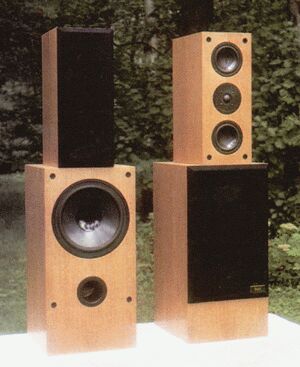
The search for a compromise between cost and quality has led me to the idea the double-hulled design of the loudspeaker, the making of which can be divided into two stages.
I suggest to first make a MF/HF-boxes through which you can listen to music, and then add bass links. Joint design of such a MF/HF-box and the bass part will save you from problems with coordination and alteration MF/HF-boxes in the second stage. In addition, many music lovers who have small speakers, to improve their acoustic system will help the results of development bass links described in this article.

In the MF/HF boxes of closed type are used for LF/MF-dynamic head of the company Peerless type 850100 (about 65.e. in a few), two each; and an RF emitter 812774 (about 70 y.e. in a few).

Low criticality of a closed casing to the scatter parameters heads makes a good play the loudspeaker. Schematics for the midrange/tweeter box shown in Fig. 1: the front panel tweeter is between low-mid-tones. Such the location enhances the directivity of the loudspeaker in horizontal plane and improves the localization of sound sources. Case made from MDF with a thickness of 16 mm, the connection of the panels is carried out on screws and glue, and as anti-vibration coating used the mastic. The internal volume is filled with a low batting the density.
The crossover scheme MF/HF-Boxing can be seen in Fig. 2: link used the third order filters, provides a frequency section of 3.2 kHz. Apply these filters to reduce the area joint radiation heads and to provide a reliable protection RF head from overload mid frequencies.
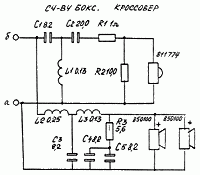
Frequency response sound pressure MF/HF-box shown in Fig. 3. In the frequency range 85 - 20000 Hz the unevenness is +2.5 dB. and the dependence of the full module resistance midrange/high-frequency part of the frequency is presented in Fig. 4. So, the minimum value of the impedance has a frequency of 5 kHz and is 3.75 Ohms, and the characteristic sensitivity of the MF/HF link is $ 88 dB/W/m.
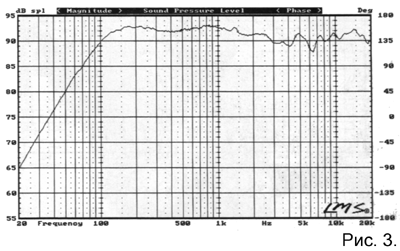
Using MF/HF-boxes can be quite successful to listen to music without bass units, but will have to put up with two of them main disadvantages: the lack of convincing the bottom and some the increase in distortion when the program has powerful bass. First the problem occurs due to the rapid decline in frequency response sound pressure at frequencies below 100 Hz. The second trouble is associated with low the frequency of oscillation amplitude of the voice coil WOOFER/mid-heads outside linear plot of stroke that causes additional distortion is not only at low but also at medium frequencies. Consider the disadvantages peculiar in one way or another all small speakers, used bass/midrange with a diameter of 100 - 130 mm with a small a linear plot of the free stroke of the voice coil.

Table 1 Fs (Hz) Qts Vas (liters) 1 28.9 0.225 105 2 30.5 0.233 97 Directory 23.5 0.190 123.5
To cope with these phenomena, it is necessary to unload MF/HF-boxes from low frequencies to play which should use a separate bass parts. They use dynamic head 850148 company Peerless (185,8 y.e. a couple of) working in peoinventari. In Table 1 given the measured parameters, which is calculated acoustic making two instances of the heads 850148, and also data from the catalog of the manufacturer. The table uses the following notation:
Fs - resonant frequency in free space,
Ots - full of merit,
Vas is the volume equivalent acoustic flexibility.
Measured and reference values differ very significantly, in other words, Feinberg, calculated with the parameters catalog, are not suitable for your heads, the characteristics of which indicated in the table.
I therefore recommend to undertake manufacturing the inverters those readers who have the ability to measure the parameters heads and calculate the inverters on the obtained results.
For the calculation of inverters, adopted the following values:
Fs = 30 Hz. Ots = 0.3. Vas = 100 l.
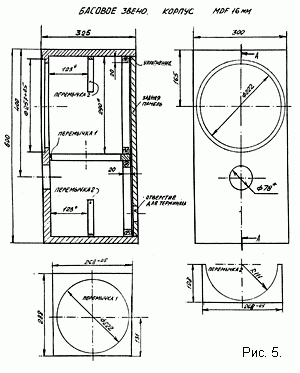
Qts increases in comparison with measured values due to the full impact on the quality of the ohmic resistance coil inductance crossover, output resistance amplifier and impedance of the cable. As a result of the calculation was chosen acoustic enclosure with a volume of 40 liters and frequency settings bass reflex 39 Hz. Drawing of the bass link is shown in Fig. 5: the case is made from MDF 16 mm thick with a coating of anti-vibration gidrostekloizol; in the same phase inverter is used a pipe with an inner with a diameter of 70 mm and a length of 110 mm.
In case you will find four jumpers, connecting the front, bottom and top side, one of jumpers divides the housing into two parts: the upper is dynamic head, and the bottom pipe of the phase inverter. The hole in the jumper small batting. The top of the body filled with the batting Nishimoto, the lower part of this material is covered with the inner surface. In this filling the housing quality factor of close to 3 phase inverter.
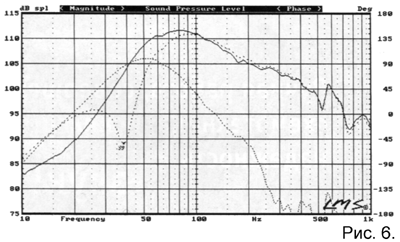
In Fig. 6 shows the frequency response sound pressure, characterizing the performance of the phase inverter. On the response of the dynamic radiation head there is a failure with a minimum at a frequency of 39 Hz, corresponding configuring the phase inverter. AFC radiation pipe bell-shaped form with smooth maximum vector difference of these two radiations and gives the resulting frequency response of the bass link. Considered response when removed the crossover, whose scheme is shown in Fig. 7. Bass head 850148 enabled through the filter of the first order with a cutoff frequency of 200 Hz. MF/HF-Boxing connects via a capacitance C3, C4 and resistor R2. The notional resistor R2 allows to adjust the tonal a balance. When considering the schematic of the crossover bass link it should be noted one peculiarity: for MF/HF-Boxing with a nominal impedance of 4 Ohms for the crossover frequency of 200 Hz the required capacity UF 132, while the total capacitance C3 and C4 is 40 UF.
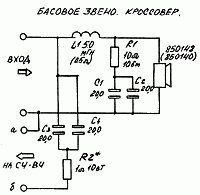
The fact is that since 200 Hz impedance module MF/HF-Boxing begins to increase, reaching at the frequency 100 Hz the magnitude of 17 Ohms. In this regard, capacity 40 UF is enough. Having a maximum at a frequency of 100 Hz, the full module resistance rapidly decreases with decreasing frequency, providing the capacitance of 40 μf effective relief MF/HF-Boxing from low frequencies.
In Fig. 8 shows the frequency response sound pressure and bass MF/HF avenew working together. The use of additional bass heads expanded the band effectively reproduced frequencies down to 45 Hz and lower distortion at medium frequencies, relieving the MF/HF-Boxing from low.

Table 2 Fs (Hz) Qts Vas (liters) 1 26.3 0.34 125.2 2 27.1 0.35 120.5 Directory 25.8 0.34 135.7
Readers who experience difficulties in measuring parameters heads and calculations of inverters, offer the option of bass link closed type with application heads 850140 (139,4 .e. in a few) that have the same mounting dimensions as 850148. Hull design the bass part does not require changes only excluded the hole for the phase inverter tube, crossover same bass level also remains intact. The woofers substantially closed type less critical to the spread of dynamic parameters heads than the phase inverter, so when it was manufactured without the use of measuring equipment much more likely to get a good result. As estimations have shown a volume of 40 liters was close to optimal for heads 850140, working in an enclosed housing. Table 2 shows the results of measurements parameters of the two instances and 850140 data from the catalog of the manufacturer.
In the case of the bass part at the closed hole the speaker's head had 850140 the resonant frequency of 48.7 and 49.6 Hz @ full dobratsch respectively to 0.67 and 0.68. For a closed acoustic design values full figure of merit close to the optimal value of 0.707 at which the recession Frequency response sound pressure at the resonance frequency is 3 dB.
As described above bass units can be used with various MF/HF boxes, picking up on the results of listening to the nominal C3, C4 and R2.
In conclusion, wish success to the readers who dare to reproduce the described design.
Publication: www.cxem.net






